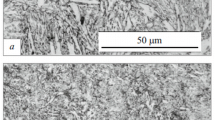Abstract
The effect of treatment in a corona discharge on the crystal structure and strength of Sendust alloy is described. The methods of x-ray diffraction analysis and nuclear gamma resonance spectrometry are used to show that treatment in a corona discharge causes redistribution of atoms and vacancies between the surface layer and the volume part of the crystallite and between its sublattices. It is shown that by treating the alloy in a corona discharge, its strength characteristics and electromagnetic parameters can be improved and the load causing the appearance of cracks can be increased considerably.
Similar content being viewed by others
References
I. P. Vereshchagin,Corona Discharge in Apparatuses of Electron-Ion Technology [in Russian]. Energoatomizdat, Moscow (1985).
E. McDaniel,Collision Phonomena in Ionized Gases, New York (1964).
N. I. Bogdanova and V. I. Popkov, “Some special features of high-frequency radiation of a corona discharge,”Dokl. Akad. Nauk SSSR,134 (6), 289–293 (1960).
S. V. Arutyunyan and Ya. P. Selisskii, “To the problem of superstructure in iron silicon-aluminum alloys,”Izv. Akad. Nauk. Arm. SSR. Fiz. 3, 8–13 (1968).
A. M. Glezer, B. V. Molotilov, V. E. Polishchuk, and Ya. P. Selisskii, “X-ray and electron-microscopic study of the fine structure of ordered Fe Si−Al alloys enriched in Fe,”Fiz. Met. Metalloved.,32 (4), 713–722 (1971).
J. Suwalski, L. Dabrowski, F. Piekoszewski, and Z. Tucholski, “Study of order-disorder transformation in Fe−Al−Si alloys by Mossbauer spectroscopy,”Phys Stat. Sol.,41, 191–195 (1977).
S. J. Cowdery and F. X. Kayser, “Lattice parameters of ferromagnetic DO structured iron aluminum-silicon alloys,”Mater. Res. Bull.,14, 91–99 (1979).
M. Kh. Shorshorov, V. P. Alekhin, and S. I. Bulychev, “On the scale dependence of hardness,”Fiz. Met. Metalloved.,43 (2), 374–379 (1977).
I. N. Gorobets, “Mobility of dislocations in pure semiconductors,”Fiz. Tv. Tela,28 (7), 2252–2254 (1986).
Author information
Authors and Affiliations
Additional information
Translated from Metallovedenie i Termicheskaya Obrabotka Metallov, No. 12, pp. 18–22, December, 1999.
Rights and permissions
About this article
Cite this article
Pomel'nikova, A.S., Peretyat'ko, V.N., Shipko, M.N. et al. Change in the crystal structure and strength of sendust alloy under the effect of a corona discharge. Met Sci Heat Treat 41, 527–530 (1999). https://doi.org/10.1007/BF02466545
Issue Date:
DOI: https://doi.org/10.1007/BF02466545




